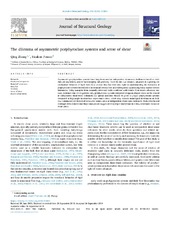The dilemma of asymmetric porphyroclast systems and sense of shear
Peer reviewed, Journal article
Published version

Åpne
Permanent lenke
https://hdl.handle.net/1956/22370Utgivelsesdato
2020-01Metadata
Vis full innførselSamlinger
Originalversjon
https://doi.org/10.1016/j.jsg.2019.103893Sammendrag
Asymmetric porphyroclast systems have long been used as independent shear-sense indicators based on their clast-tail asymmetry and/or stair-stepping tail geometry. Over the last two decades, advances in exploring the mechanical behavior of rigid clasts in a viscous flow has shed new light on understanding the formation of porphyroclast systems embedded in noncoaxial viscous flow and subsequently quantifying many aspects of flow kinematics. Using examples from naturally deformed rocks combined with results from recent advances, our study indicates that: (1) in general, only porphyroclast systems composed of equant-shaped clasts can be treated as independent shear-sense indicators; (2) special attention should be given to β-type porphyroclast systems composed of high-angle intermediate aspect-ratio clasts, which may contain meaningful information on bulk flow kinematics; (3) bookshelf structures cannot serve as independent shear-sense indicators. Multi-criteria and thorough three-dimensional shape analyses are suggested for a proper interpretation of flow kinematics in ductile shear zones.
